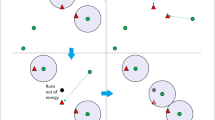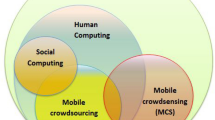Abstract
Opportunistic sensing has become an appealing mobile crowd sensing (MCS) paradigm due to the fact that it can reduce the energy consumption and cost of cellular network connections. However, its success rate and transmission speed depend on the social interaction and mobility patterns of nodes. In this paper, we provide a spatiotemporal opportunistic transmission method for MCS networks. Firstly, to characterize the mobility patterns and social attributes of nodes more precisely and combine their advantages, this method defines spatiotemporal encountering and visiting parameters related to specific space-time units for nodes in a MCS network. Further, to realize reliable opportunistic transmission across regions and time intervals, this method searches publishers or participants of sensing tasks in a space-time unit according to the spatiotemporal encountering parameters of nodes in the unit and tracks the publishers or participants across the space-time units according to the spatiotemporal visiting parameters of nodes. The simulation results verify that the proposed method can achieve higher success rate with less transmission delay than existing typical methods.










Similar content being viewed by others
References
Ganti RK, Ye F, Lei H (2011) Mobile crowd sensing: current state and future challenges. IEEE Commun 49(11):32–39
Zheng Y, Liu F, Hsieh H (2013) U-air: when urban air quality inference meets big data. ACM Proceedings of the 19th SIGKDD International Conference on Knowledge Discovery and Data Mining, pp 1436–1444
Maisonneuve N, Stevens M, Niessen M et al (2009) Noisetube: measuring and mapping noise pollution with mobile phones. Inform Technol Environ Eng 2(6):215–228
Koukoumidis E, Peh L, Martonosi MR (2011) Signalguru: leveraging mobile phones for collaborative traffic signal schedule advisory. ACM Proceedings of the 9th International Conference on Mobile Systems, Applications, and Services, pp 127–140
Miluzzo E, Lane ND, Fodor K, et al (2008) Sensing meets mobile social networks: the design, implementation and evaluation of the CenceMe application. ACM Proceedings of the 6th Conference on Embedded Network Sensor Systems, pp 337–350
Yu Z, Guo W, Zhang D, Wang L, Guo B (2020) Cyber-physical-social-mediated communication. IT Professional 22(2):60–66
Capponi A, Fiandrino C, Kantarci B, Foschini L, Kliazovich D, Bouvry P (2019) A survey on mobile crowdsensing systems: challenges, solutions, and opportunities. IEEE Commun Surv Tutorials 21(3):2419–2465
Ra M, Liu B, Porta T, et al (2012) Medusa: a programming framework for crowd-sensing applications. ACM Proceedings of the 10th International Conference on Mobile Systems, Applications, and Services, pp 337–350
Das T, Mohan P, Padmanabhan VN, et al (2010) PRISM: platform for remote sensing using smartphones. ACM Proceedings of the 8th International Conference on Mobile Systems, Applications, and Services, pp 63–76
Hicks J, Ramanathan N, Kim D, et al (2010) Andwellness: an open mobile system for activity and experience sampling. ACM Wireless Health, pp 34–43
Xiong H, Zhang D, Wang L, Chaouchi H (2015) EMC3: energy-efficient data transfer in mobile crowdsensing under full coverage constraint. IEEE Trans Mob Comput 14(7):1355–1368
Wang L, Zhang D, Yan Z, Xiong H, Xie B (2015) Effsense: a novel mobile crowd-sensing framework for energy-efficient and cost-effective data uploading. IEEE Trans Syst Man Cybern 45(12):1549–1563
Fall K, Farrell S (2008) DTN: an architectural retrospective. IEEE J Sel Areas Commun 26(5):828–836
Lindgren A, Doria A, Schelén O (2003) Probabilistic routing in intermittently connected networks. ACM Sigmobile Mobile Comput Commun Rev 7(3):19–20
Daly EM, Haahr M (2009) Social network analysis for information flow in disconnected delay-tolerant MANETs. IEEE Trans Mob Comput 8(5):606–621
Yu Z, Zhang D, Yu Z, Yang D (2015) Participant selection for offline event marketing leveraging location based social networks. IEEE Trans Syst Man Cybern Syst 45(6):853–864
Lane ND, Miluzzo E, Lu H, Peebles D, Choudhury T, Campbell A (2010) A survey of mobile phone sensing. IEEE Commun Mag 48(9):140–150
Khan WZ, Xiang Y, Aalsalem MY, Arshad Q (2013) Mobile phone sensing systems: a survey. IEEE Commun Surv Tutorials 15(1):402–427
Fiandrino C, Kantarci B, Anjomshoa F, et al (2016) Sociability-driven user recruitment in mobile crowd sensing internet of things platforms. IEEE Global Communication Conference, pp 1–6
Han K, Zhang C, Luo J (2014) BLISS: budget limited robust crowd sensing through online learning. IEEE 11th International Conference on Sensing, Communication, and Networking, pp 555–563
Balasubramanian N, Balasubramanian A, Venkataramani A (2009) Energy consumption in mobile phones: a measurement study and implications for network applications. ACM Proceedings of the 9th SIGCOMM Conference on Internet Measurement, pp 280–293
Wang L, Zhang D, Xiong H, Gibson JP, Chen C, Xie B (2017) Ecosense: minimize participants’ total 3G data cost in mobile crowd sensing using opportunistic relays. IEEE Trans Syst Man Cybern 47(6):965–978
Han Y, Zhu Y, Yu J (2015) Utility-maximizing data collection in crowd sensing: an optimal scheduling approach. IEEE 12th International Conference on Sensing, Communication, and Networking, pp 345–353
Capponi A, Fiandrino C, Kliazovich D, Bouvry P, Giordano S (2017) A cost-effective distributed framework for data collection in cloud-based mobile crowd sensing architectures. IEEE Trans Sustain Comput 2(1):3–16
Jain S, Fall K, Patra R (2004) Routing in a delay tolerant network. ACM SIGCOMM Comput Commun Rev 34(4):145–158
Vahdat A, Becker D (2000) Epidemic routing for partially-connected ad hoc networks. Duke Tech Report CS-2000-06
Spyropoulos T, Psounis K, Raghavendra CS (2008) Efficient routing in intermittently connected mobile networks: the multiple-copy case. IEEE/ACM Trans Networking 16(1):77–90
Balasubramanian A, Levine B, Venkataramani A (2007) DTN routing as a resource allocation problem. ACM SIGCOMM Comput Commun Rev 37(4):373–384
Lee K, Yi Y, Jeong J, et al (2010) Max-contribution: on optimal resource allocation in delay tolerant networks. IEEE Proceedings of the 29th Conference on Information Communications, pp 1136–1144
Hui P, Crowcroft J, Yoneki E (2011) BUBBLE rap: social-based forwarding in delay-tolerant networks. IEEE Trans Mob Comput 10(11):1576–1589
Yuan P, Liu P, Tang S (2014) Exploiting partial centrality of nodes for data forwarding in mobile opportunistic networks. IEEE 17th International Conference on Computational Science and Engineering, pp 1435–1442
Link JAB, Schmitz D, Wehrle K (2011) GeoDTN: geographic routing in disruption tolerant networks. IEEE Global Telecommunications Conference, pp 1–5
Chen K, Shen H, Yan L (2016) DSearching: using floating mobility information for distributed node searching in DTNs. IEEE Trans Mob Comput 15(1):121–136
Henderson T, Kotz D, Abyzov I (2004) The changing usage of a mature campus-wide wireless network. Comput Netw 52(14):2690–2712
Zhang X, Kurose J, Levine BN, et al (2010) Study of a bus-based disruption-tolerant network: mobility modeling and impact on routing. Proceedings of International Conference on Mobile Computing and Networking, pp 195–206
Funding
This work was supported in part by the National Natural Science Foundation of China under Grants 61802257 and 61602305 and by the Natural Science Foundation of Shanghai under Grants 18ZR1426000 and 19ZR1477600.
Author information
Authors and Affiliations
Corresponding author
Ethics declarations
Conflict of interest
The authors declare that they have no conflict of interest.
Additional information
Publisher’s note
Springer Nature remains neutral with regard to jurisdictional claims in published maps and institutional affiliations.
Rights and permissions
About this article
Cite this article
He, X., Liu, M. & Yang, G. Spatiotemporal opportunistic transmission for mobile crowd sensing networks. Pers Ubiquit Comput 27, 551–561 (2023). https://doi.org/10.1007/s00779-020-01439-7
Received:
Accepted:
Published:
Issue Date:
DOI: https://doi.org/10.1007/s00779-020-01439-7




